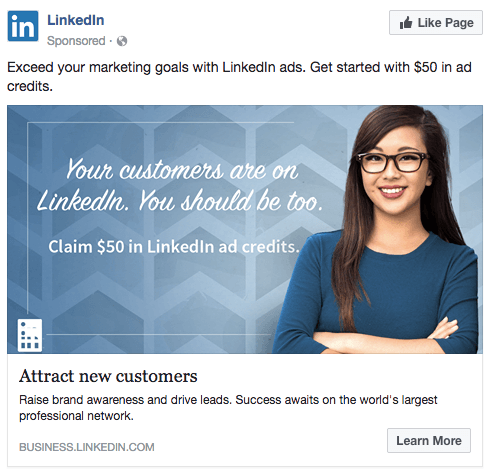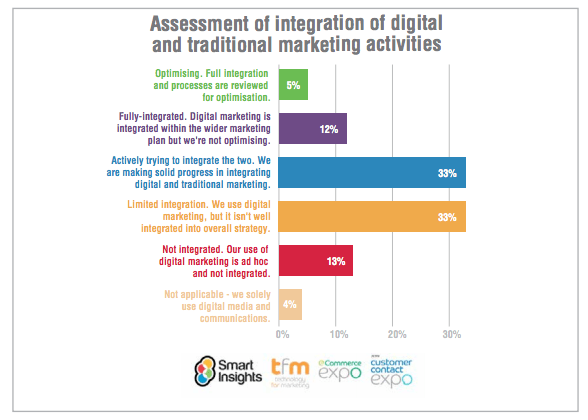According to a report from Accenture, 87% of Americans use a second screen device while watching TV. Google also reports that 90% of people switch between multiple devices to complete a single task.
Not only are more people online than ever before, but they’re also constantly switching between different devices to get the experience they want. More connectivity means greater personalization. For today’s marketers, that means they need to give prospects a seamless, personalized experience across all channels.
Imagine walking into a department store and everything on your shopping list was already gift wrapped and waiting for you at the register. You would feel like you got the VIP treatment right? You’d probably become a repeat customer and tell your friends about your great experience.
That’s the feeling that marketing across multiple channels can inspire in prospects. Marketers are using data to track what prospects want so that they can deliver relevant ads at the right time.
A big part of delivering ads that prospects actually want to see is retargeting. By targeting ads at prospects that have already shown interest on another channel, marketers know they’re delivering their message to a more receptive audience, which can lead to higher conversions. (For more information how to use post-click landing pages at the top of your funnel, go here.)
Cross-channel marketing and retargeting
Perhaps you were looking for a new sweater as the summer months came to a close and the weather started getting cooler. You looked at several sites and eventually found the perfect red-striped sweater. You put the sweater in your shopping cart only to get distracted by that new Netflix show you’d been dying to see. While browsing Facebook the next day you notice an ad for the sweater you forgot to purchase staring you in the face.
That’s retargeting at work:

When done right, one study explains that users who visit your website and later retargeted with display ads are 70% more likely to convert. Retargeting works using cookies to “follow” prospects on the web — showing related ads to the user’s initial purchase intent in hopes of bringing them back to purchase. This provides prospects with a personalized experience based on their preferences.
After a few visits to LinkedIn’s website and learning about the LinkedIn Marketing program, their ads started appearing on my Facebook timeline. Here’s the ad:

Once clicked, it took me to this page (click through to see the full page below the fold):

The discount in the headline and the CTA copy is persuasive, but the help center and blog links in the navigation take the focus away from the offer. Overall, though, it’s an excellent example of the type of page you want visitors to arrive after clicking an ad.
Another retargeting example comes from Old Navy. I was on my phone shopping for boat shoes and placed some faux-leather shoes in my shopping cart. I didn’t end up purchasing the first time around, but did enter my name and email address into the multi-page checkout process before leaving the site. A few days later an email reminded me about my shopping cart and offered me 40% off the purchase price:

Old Navy sent me a personalized email based on my online shopping behavior to convince me to revisit their site and complete the purchase. Their marketing team knows that retargeting works and has likely increased their ad spend ROI because they’re only sending these emails to prospects who’ve shown previous interest.
Difficulties in cross-channel marketing attribution
Attribution can be relatively easy when it comes to traditional digital marketing campaigns. For instance, marketers can track click-through rates for display ads, open rates for emails, and impressions for search.
But when marketing across multiple channels, attribution can get more challenging. Someone may click a Google ad and get sent to a post-click landing page. From there, if they don’t convert, they could be served an ad on Facebook or Twitter. By the time the prospect becomes a customer, it’s hard to tell which ad should get the credit for the sale. Was it the initial Google ad or the retargeting ad on Facebook?
This is an example of the more complex questions that marketers face as cross-channel marketing campaigns continue to grow in size and scope. But proper attribution is still something that is necessary to maximize your conversions and ROI.
In an attempt to give credit where credit’s due, attribution models have been developed that assign credit based on the different touchpoints prospects interact with before purchasing. However, there’s debate among digital marketers about which models are most accurate. The different attribution models are:
- The last interaction model gives all of the credit for conversion to the last touch point that the prospect interacted with.
- The first interaction model gives all of the credit for conversion to the first touch point that the prospect interacted with.
- The linear interaction model assigns all touch points equal credit.
- The time decay model assigns the last touch point the most credit, and gives each touch point closer to the first interaction less credit for the conversion.
- The position based model gives the middle points less credit than the beginning and end points.
This graphic from Mediaocean displays a visual representation of the different attribution models:

Which attribution model do you follow and think is the most accurate?
How post-click landing pages fit into cross-channel marketing
Since post-click landing pages are designed for conversion and use persuasive elements like compelling headlines, visual cues, and contrasting CTAs to get prospects to take action, it’s no surprise that cross-channel campaigns use post-click landing pages. For example, when you serve a retargeting ad to a prospect, you want to send them to a post-click landing page and persuade them to convert. Let’s take a look at a few examples.
After my subscription to The Wall Street Journal had expired, I started to receive promotional emails. Not only were the ads timely, they included enticing incentives to re-subscribe, like a 50% discount that “ended soon” creating a sense of urgency. Here’s the ad:

Clicking on the ad sends visitors to the post-click landing page below. The headline and subheadline use message matching, the page doesn’t include a navigation, and is solely focused on generating conversions:

Clearly, their marketing team understands that sending prospects who click on an ad to an optimized post-click landing page will lead to more subscriptions.
Another retargeting example occurred when, while researching presentation companies, I found VidMob, a company that helps businesses advertise on Snapchat. After visiting their website, VidMob’s ads followed me on social media. Here’s the Facebook ad that appeared in my feed:

Clicking the ad takes visitors to this signup post-click landing page:

This post-click landing page has no menu navigation, a short lead capture form to reduce friction, and the eye gaze visual cue pointing towards the CTA. The next time you use retargeting ads, follow The Wall Street Journal and VidMob’s examples when designing a custom post-click landing page to convert your traffic.
The future of cross-channel marketing
A 2016 study from the Interactive Advertising Bureau found that 57.6% of marketers believed marketing across multiple channels and attribution will be a top priority. The future of marketing across multiple channels starts with simplifying the attribution process and making it easier for marketers to understand which touchpoints are having the most impact on conversions.
Without accurate data on which touchpoints are the most effective, marketers can’t fully optimize their marketing campaigns. New attribution models and tools that make the process more accurate can have a major positive impact on a marketing campaign’s ROI.
The siloed approach and beacons
Another multi-channel marketing trend is the elimination of the siloed approach to campaign management. Under the siloed approach, marketing departments had separate teams for mobile, search, and social. These teams were managed independently and had separate goals and strategies. These teams were focused on their individual channels instead of a comprehensive marketing campaign that provided prospects with a consistent experience as they switched channels.
The future of cross-channel marketing is the elimination of silos, but it also rests in other innovative technology like beacons. Beacons are a relatively new cross-channel marketing strategy that has potential for massive growth (more than 1 million beacons were installed by retail stores in 2016 alone).
Currently, beacons are primarily used to push notifications to a prospect’s phone.
When a prospect is near a company’s store, beacons send a push notification to their phone with a special offer. But beacons are expected to become more sophisticated, such as sending prospects notifications when foot traffic is low at their favorite stores or restaurants so they won’t have to wait in line upon arrival.
According to retail analytics firm, Swirl, beacons have been shown to increase the likelihood of purchase by 73%:
![]()
As marketers are able to collect new data on consumer buying behavior, prospects will expect offers to become more personalized.
Marketers are discovering that discounts aren’t the only thing that drives sales. Some prospects are more likely to convert on one channel over another, while others need a promotion or exclusive offer to buy.
Creating a cross-channel marketing strategy
Marketing across several channels is about taking prospects on a journey because they won’t necessarily convert on the first page they arrive at. Consistency throughout the campaign is critical.
You want your prospects to have the same brand experience across channels. The journey that your prospects take before converting can take days or even weeks on multiple channels. Several companies offer solutions for marketing across multiple channels, including Adobe, Experian, and Selligent.
It’s difficult to market across channels if your channel managers aren’t talking to each other. That means you may have to rethink how your email, social, mobile, and paid advertising teams collaborate. These teams need to provide prospects with a consistent experience across channels and make them personalized offers when prospects are ready to purchase.
Silos are still a major problem for digital marketers and are holding back the optimization efforts. Last year Experian reported that 59% of enterprise marketers in their survey break teams out by channel. There are still significant barriers to the integration of digital and traditional marketing teams. In addition, Smart Insights’ research indicates that 46% of companies have limited or no integration between digital and traditional marketing:

With a consistent experience across channels and a marketing team that has removed silos, your company could execute a viable multi-channel marketing strategy that increases conversions and sales. But you still need to make use of customer data to optimize the campaign and give your prospects the best possible experience.
What channels are your prospects most likely to convert from? What times are your prospects the most responsive? Are you retargeting prospects on channels that will push them to convert?
You don’t want to nurture a prospect through your marketing funnel only to have them land on a page that isn’t focused on your offer and distracts them with other content. post-click landing pages are designed for conversion, which makes them the ideal place for your prospects to arrive after clicking an ad. Providing an integrated experience will give prospects a more personalized experience and increase conversions.
Your brand and cross-channel marketing
What cross-channel marketing strategies will your company incorporate into its next campaign? How will you provide an integrated and consistent experience to your prospects?
Determine your attribution model, sign up for an Instapage Enterprise demo today.

See the Instapage Enterprise Plan in Action.
Demo includes AdMap™, Personalization, AMP,
Global Blocks, heatmaps & more.
